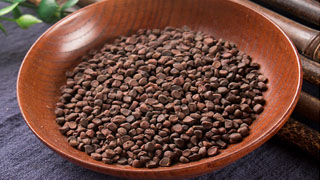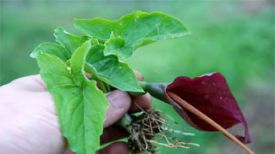
1. Alias
Lishi, Malianzi, Malianzi, Lishi.
2. Plant morphology
Perennial herb. The rhizome is short and thick, with brown roots that are slender and tough. The leaves are basal, clustered, and tough. After the leaf sheaths die, they often crack into slender fibrous residues. The leaves are strip-shaped, gray green, with a pointed tip and a purple base. They are entire and have 7-10 parallel veins on both sides. The scape is extracted from the leaf cluster, with 3 bracts, blue purple flowers, 6 perianth, and 3 outer whorl. The perianth is large, spoon shaped, curved outward and drooping, with yellow stripes in the middle. The inner whorl has 3 perianth segments that are lanceolate and upright. The lower part of the perianth is combined into a tube shape. The style is deeply lobed with 3 petals, and the top is 2-lobed. The capsule is oblong in shape, with 6 longitudinal ribs and a pointed beak at the tip. The seeds are nearly spherical or irregularly shaped, brown in color, and angular.
3. Origin distribution
Born in the fields of sunny mountains, along roadsides, ditches, grasslands, and meadows, it is also often planted next to flower beds in courtyards. Distributed in Heilongjiang, Jilin, Liaoning, Inner Mongolia and other places.
4. Harvesting and processing
Harvest fruits in autumn, dry them in the sun, knead the seeds, sieve them, stir fry until cooked, crush them, or stir fry with vinegar.
5. Characteristics of medicinal herbs
Irregular polyhedron, approximately 5 millimeters long and 3-4 millimeters wide. The surface is reddish brown to dark brown, with slight fine wrinkles. The base has a light colored navel, which is hard and not easily broken. The endosperm on the cut surface is well-developed, gray white, keratinous, and the embryo is located at one end of the navel, white and slightly curved. The air is weak and the taste is light.
6. Sexual Taste Returning to the Classics
Flat in nature, sweet in taste. Return to the liver meridian, stomach meridian, spleen meridian, and lung meridian.
7. Effect and Function
Clearing heat and dampness, reducing swelling and detoxifying, and stopping bleeding. Cold blood hemostatic drugs classified under the category of hemostatic drugs.
8. Clinical application
Take 5-10 grams of decoction orally; Or into pills or powder. Treat jaundice hepatitis, dysentery, vomiting blood, bleeding, blood collapse, vaginal discharge, pharyngitis, abscess, and hernia. Apply an appropriate amount of external massage. Treatment for bone tuberculosis: Stir fry and grind Ma Linzi in an iron pot, take orally, 3 times a day, 5-7 grams each time, and reduce for children.
9. Pharmacological research
Has strong anti-tumor activity, enhances tumor cell sensitivity to radiation, has anti radiation effects, promotes immune function, and has anti fertility, anti implantation, and other effects. Intraperitoneal injection or oral administration of irisin has significant anti-cancer effects on mouse cervical cancer, lymphosarcoma, ascites type liver cancer, etc; Both irisin A and irisin B have significant radiosensitizing effects, with no bone marrow suppression side effects observed in both anti-cancer and radiosensitizing effects; The combination of irisin A, doxorubicin, and cephalotaxine can block the drug resistance of leukemia cell lines; Intraperitoneal or oral administration of irisin has a significant immune enhancing effect on delayed hypersensitivity reactions in normal mice or tumor bearing mice, as well as non-specific immune phagocytic function. Toxicity: The intraperitoneal LDso of irisin in mice is (25.4 ± 1.9) g/kg.
10. Chemical composition
The ether soluble part of the seed coat contains irisin A, irisin B, irisin C, etc. It also contains components such as olefen-3-one, betulinic acid, β - sitosterol, plant wax, and various fatty acids.
11. Usage taboos
Prohibited for those with dry heat, and used with caution for those with spleen deficiency and loose stools.
12. Compatibility prescription
① To treat jaundice and hepatitis, with yellow and light urine: a. Take 9g of irises in water decoction. (Ningxia Chinese Herbal Medicine Handbook) B. 9g of Iris and 15g of Artemisia scoparia. Boil it in water. (Hubei Journal of Chinese Herbal Medicine)
② To treat various types of turbidity: Take 60g of fresh irises, add 15g of rock sugar, boil in moderate water, stew, and take before meals. (Fuzhou Taijiang "Practical Folk Herbs")
③ Difficulty urinating: 6g of irises and 9g of plantain. Boil it in water. (Shandong Herbal Medicine Handbook)
④ To treat urinary obstruction: a. Take 6g of Ma Lin Zi, crush it, and boil it in water. (Tianjin Chinese Herbal Medicine) b. 25 grams of Iris, 10 grams of Platycodon grandiflorus, and 10 grams of Eucommia ulmoides. Boil in water and take on an empty stomach twice a day. (Jilin Chinese Herbal Medicine)
⑤ At the beginning of treating dysentery: 9g of irises and 9g of yellow prickly skin. Boil it in water. (Xining Chinese Herbal Medicine)
⑥ To treat food accumulation: Stir fry and burn Ma Lin Zi, take 9 grams per serving. (Medicinal Plants in Desert Areas)
⑦ Treatment of carbuncles and sores: 6g of irises, 30g of purslane, and 30g of dandelion. Boil it in water. (Qingdao Herbal Medicine Handbook)
⑧ Treatment for nosebleeds and vomiting: 6g of irises, 30g of white fescue root, and 15g of cactus grass. Boil it in water. (Shandong Herbal Medicine Handbook)
⊙ The content of the article is for clinical reference only. Non TCM professionals are not allowed to test drugs.


